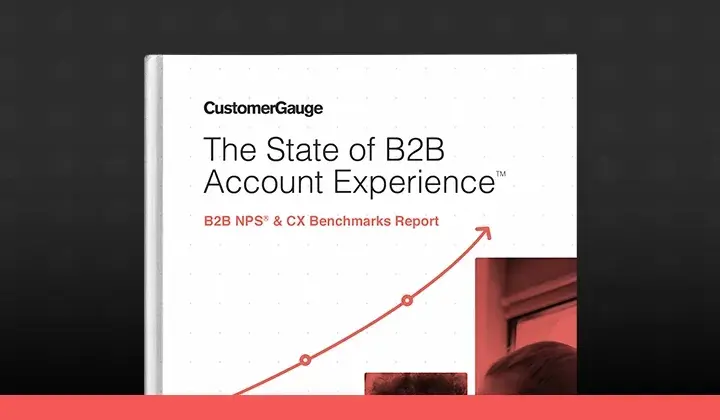Yet too many brands aren’t getting it right. According to CustomerGauge research, only 20% of businesses understand how CX supports their overall business strategy.
If you’re not connecting the two, you’re flying blind—and that means missing crucial opportunities for growth. One study suggested that companies who committed to customer experience grew their revenues by as much as 8% above the market.
So, how can you get started? By building a customer experience management strategy that ties CX data to your bottom line.
Here, we take you through how to do just that. No matter your industry, the core steps of your CXM strategy are to Measure, Act, and Grow.
Here’s how.
What is a Customer Experience Management Strategy?
A customer experience management strategy is the framework you use to measure, analyze, and optimize your customer experience—and, when done properly, to track its impact on your revenue.
In this way, your CXM strategy’s first priority is to gather hard data on customer experience and link it to its impact on your wider business goals.
You can’t take this for granted. Our research shows that 70% of companies don’t link their CX data to financial data. 62% aren’t even calculating the ROI of their CX efforts.
If you’re not connecting your CX to your bottom line, you’re probably not being strategic about your CX and you’re likely going to struggle to win internal buy-in for customer experience management
And internal buy-in is critical for a successful CXM strategy.
So before we dive into how to build one, let’s first take a look at why your CXM strategy matters so much for your business
Why Do You Need a Customer Experience Strategy?
- Deliver a better experience to your customers. By committing to your CX efforts, you’ll get visibility on what your customers like, need, and want to change at every stage of their journey. This matters: studies suggest happy customers tend to stay for longer and spend 140% more.
- Make CX measurable. Getting strategic about CX means putting the tools in place to measure your customers’ sentiments. While tracking Net Promoter Scores in B2C contexts is pretty straightforward, B2B brands often struggle to keep up with sentiments across different accounts.
- Understand the value of your CX efforts. Without a concrete CXM strategy, you can’t understand the financial impact of your CX. That means you can’t prove the worth of your CX program—nor have insight into the best opportunities for growth.
- Finally, drive business growth. When done right, a CXM strategy can tell you which accounts are most at-risk of churn and which can boost referrals. When 80% of revenue comes from 20% of customers, understanding the value of each account is crucial. And a CXM strategy is the only way to do it.
Yet not all customer experience strategies are born equal. At CustomerGauge, we help our customers develop a CXM strategy that drives revenue outcomes—so that customer feedback is always used to drive new growth.
When designing your CX strategy, there are some key things you should look for:
What Makes a Good Customer Experience Management Strategy?
To deliver the benefits your business deserves, your CXM strategy should do 5 things:
- Put customer data first. Too many CX efforts can be wishy-washy, imprecise, and unsupported by real numbers. But without hard CX data, your strategy won’t come to anything.
- Enable flexibility in handling customers. No two customers are the same—and your CXM strategy shouldn’t be a rigid plan that treats them as such. Instead, frontline staff, middle managers, and executives should have the flexibility to respond to every customer’s concerns.
- Get buy-in from everyone in your organization. For you to become a customer-centric organization, your customer experience needs to become everyone’s job. Your strategy should reflect that.
- Account for CX software and tools. CXM platforms like CustomerGauge are indispensable for keeping track of CX across accounts.
- Connect customer experience to revenue. Finally, it’s worth repeating. Your CXM strategy must link up your customer sentiments to your bottom line.
So, how can you build a customer experience program that does all of these things? The answer is by using CustomerGauge’s monetized NPS methodology.
How to Create a Customer Experience Management Strategy Using Account Experience
At CustomerGauge, we’ve built a CXM strategy around three simple steps: Measure, Act, and Grow (deep dive the framework here). These provide the key elements for you to deliver CX for growth.
Does it work? You bet. By implementing CustomerGauge’s CX program, SmartBear brought in $6 million in referrals in just 18 months. We can help you do the same.
Let’s show you how we do it.
To start with, our CXM strategy works using the traditional NPS framework—but with a twist:
Standard NPS Management Framework vs Monetized NPS
The Net Promoter Score metric is fundamental to so many customer experience strategies. That’s because it is incredibly powerful.
It’s a simple, measurable, and scalable tool to help you test the temperature of your customer sentiment.
But for your CXM strategy to be up to today’s challenges, you’ll need to reboot this traditional metric. Instead, you need monetized NPS.
The fundamentals are the same. You’ll still ask the simple NPS question:
On a scale from 0 to 10, how likely is it that you would recommend our company/product/service to a friend or colleague?
Then, based on the response, you will still categorize your customers into detractors (0-6), passives (7-8), and promoters (9-10). Detractors won’t recommend your brand and may even spread negative word of mouth. But promoters will be your brand advocates and will have the biggest impact on your profits.
While NPS ends there, monetized NPS gives you a lot more value.
With monetized NPS, you’ll be able to calculate a precise figure of revenue for every NPS point. That means identifying:
- The value of detractors and promoters. If your largest accounts make up a big share of your detractors, you have a serious threat to your revenue. But you don’t know this if you don’t monetize your NPS.
- The specific cost of each driver. Your NPS survey could tell you that your onboarding process is having the biggest negative impact on your CX. By monetizing your NPS, you know exactly how much that could potentially cost your business.
This is how you put it into place:
Step 1: Measure
Your CXM strategy starts with measurement—and that means measuring NPS. The hard data you collect will inform the basis of your strategy. That means it is crucial you get it right.
To start with, you’ll need to ask two specific types of survey:
- Relationship surveys. These take the temperature of your customer sentiment through a short survey every quarter. Every quarter may sound like a lot, but it’s definitely worth the effort. At CustomerGauge, we found that companies that survey their customers quarterly see a 5.2% increase in retention.
- Transactional surveys are triggered after a purchase or other specific transaction. These should be tied directly to different touchpoints in the customer journey, to help you understand the specific drivers behind your customers’ sentiments.
So far, so good. But CXM strategy doesn’t end there. Don’t let analysis lead to paralysis:
Step 2: Act
The next stage of your strategy is about addressing your customer concerns. This happens in two different steps: closing the loop and optimization.
- Closing the loop. Based on your data, it’s time to address your customers’ needs. Every customer is different, so you’ll need to be prepared to act based on their specific sentiments. Then, we suggest you reach out to them to close the loop within two weeks maximum—but two days is even better.
- Optimization. According to CustomerGauge research, companies that set targets for NPS growth grew twice as fast as those that didn't. Yet too many businesses just aren’t doing that. The optimization stage of your strategy makes setting goals—and tracking your progress toward them—a priority.
Step 3: Monetize & Grow
Finally, it’s time to grow. That means identifying how NPS growth impacts your bottom line—then putting in steps to boost it.
- Monetize. Aggregate your detractors, passives, and promoters to understand how an increase in NPS can increase your revenue. You should be able to attribute a specific portion of revenue to any increase in your NPS score.
- Identify your at-risk and your safe customers. Understanding which customers are most likely to churn is a key part of your growth strategy. Reaching out to them more often will encourage them to stay.
- Make targeted optimizations. Knowing the value of each of your customers helps you to drive retention, referrals, and repurchases. Encouraging cross-sales and up-sales among promoters may be most effective in increasing your bottom line.
CustomerGauge makes this easy. After adopting our monetized NPS strategy, Alchemista went from losing their most valuable client to boasting a 100% retention rate. You can too.
Other Customer Experience Management Strategies
Ours is not the only CXM strategy out there. But we’re proud that it’s the most effective in targeting your bottom line.
Aside from CustomerGauge’s strategy, here are some alternative CMX strategies to consider:
- Qualtrics Customer Experience (CX) Strategy focuses on understanding your customer. It does this through three steps: building customer personas, mapping the customer journey and imagining a future experience for your customers.
But while this provides a really rich image of who your customers are, it doesn’t have much to say about linking CX to revenue—nor about the right actions for growth.
- Hubspot Customer Experience Strategy. Hubspot outlines an eight-stage strategy for improving customer experience, including training your customer service staff, collecting feedback, and tracking your team’s performance.
Yet the perspective here is limited. Customer service is not the only team responsible for CX.
- B2B International CXM Strategy. B2B International’s strategy emphasizes the importance of whole-organization buy-in when it comes to customer experience. Yet failing to consider and monetize NPS surveys is seriously limiting their effectiveness.
CustomerGauge is the only customer experience management strategy that is explicit in linking CX with your revenue. Only this way can you be sure that happy customers walk hand-in-hand with business growth.
Want some juicy strategic advice? Try this: Advanced B2B CX Strategies Nobody Talks About
Customer Experience Strategy Best Practices
With a CXM strategy in mind, it’s time to start actually improving your customer experience. This isn’t a one-off task, but a commitment that will change your organization long into the future.
To ensure you’re getting the best out of your CX program in the long term, here are some best practices to remember:
- Link NPS to revenue as tightly as possible. To understand the real value of your CX, you should be able to attribute a specific financial sum to every NPS point.
- Get buy-in from the whole organization. CX is not customer service. For your CXM strategy to be a success, everyone should be on the same page across functions. That includes your c-suite too.
- Combine relationship surveys with transactional surveys. CustomerGauge research shows that using both can increase customer retention by nearly 5%.
- Remember the importance of NPS. As your priorities change into the future, it’s easy to take NPS for granted. Don’t. Returning to your customers regularly will keep your CXM efforts fresh and relevant. Read more: What is a good NPS score?
- Invest in technology that supports your strategy. Tools that can automate your CXM processes and give you actionable insights to improve will be indispensable.
Conclusion: CX and Revenue Growth Go Hand-in-Hand
The right customer experience management strategy enables you to boost customer happiness while driving your bottom line.
CustomerGauge helps you make CX and revenue growth go hand-in-hand. Book a demo today to find out how.


